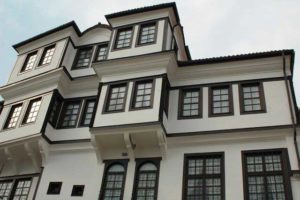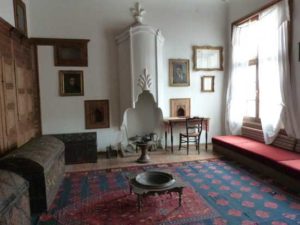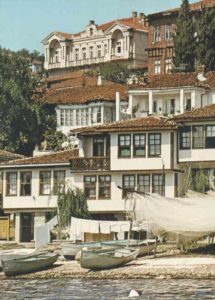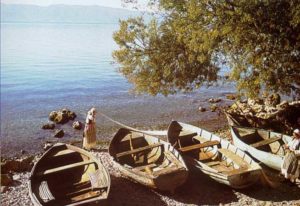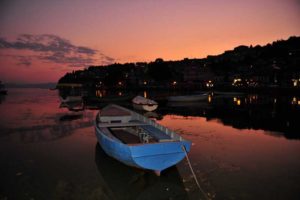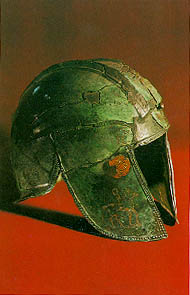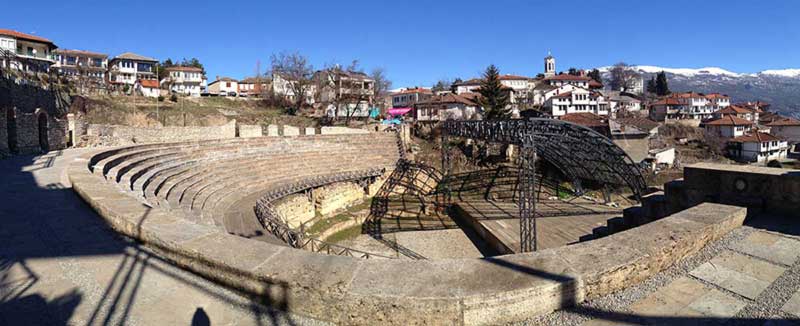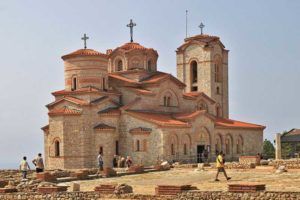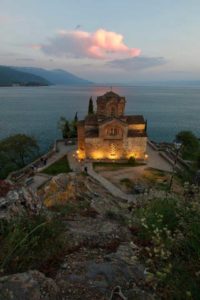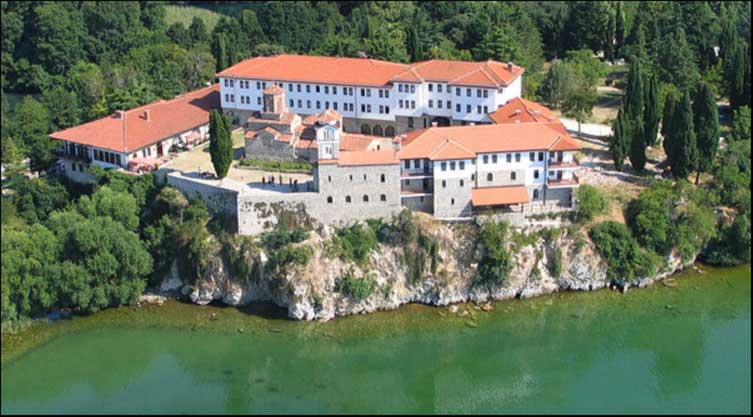TThe ancient city of Ohrid, situated along the coast of the magnificent Lake Ohrid, is undoubtedly the most beautiful and most attractive Macedonian town, a pearl of old architecture and a treasury of valuable cultural and historical monuments. Located on the shores of Lake Ohrid, the town of Ohrid is one of the oldest human settlements in Europe. Its ancient name was Lichnidos, which was used to refer to the settlement of Ohrid and the lake. Built mostly between the 7th and the 19th century, it has the most ancient Slav monastery (St. Pantelejmon) and more than 800 icons of Byzantine style, painted between the 11th and the end of the 14th century, which are considered to be, after those of the Tretiakov Gallery in Moscow, the most important collection in the world.
Ohrid could literally be called a city-museum – another typical mixture of the western and the oriental, a city with a special architecture, and modern, luxurious tourist facilities. One should have heard of the long tradition in making the famous Ohrid pearl, as well. Ohrid is a town which has always been of interest to every visitor to Macedonia. It is Macedonia’s main tourist center, with first class hotels, modern tourist objects of international fame, camp sites, company hotels and holiday homes, as well as a large number of ancillary tourist, hotel and gathering facilities.
There are three tectonic lakes in Macedonia: Lake Ohrid, Lake Prespa and Lake Dojran. Lake Ohrid is the biggest and certainly the most beautiful of them. It lies 695 m. above sea level, covering an area of 349 sq. km. Its extraordinary clean and clear waters (the transparency of the water is 21,5 meters) and primordial beauty look breathtakingly fascinating to both the passers-by and numerous domestic and foreign tourists who continuously visit this lake.
The ancient city of Ohrid and the Ohrid region are recorded in UNESCO’s directory of worlds cultural heritage and have been placed under environmental protection as an outstanding environment. The lake is fed by cold spring water that flows from Lake Prespa; it is one of the oldest and deepest lakes in the world, full of living fossils such as the Ohrid trout (Salmo letnica)and other species found nowhere else. The high mountain Galicica proudly rises between lakes Ohrid and Prespa with its imposing posture looking like an eternal guardian of the two lakes.
The ancient name of Ohrid was Lychnydos, based on an ancient stone inscription that was found that reported of King Philip’s II take-over of the city in 353 BC; the earliest evidence of the current name of the town is from 879. Apart from a theatre, Lychnidos also possessed other buildings such as an agora, a gymnasium, a boulevterion, a civil basilica and temples. Under Roman rule Lychnidos developed into a typical Roman city and an important transit point on the road Via Egnatia.
Near the village of Trebenishta, on the road from Ohrid to Kichevo, a number of graves were found to contain burial gifts of remarkable intrinsic and artistic value. The site was discovered in 1918, and the treasures of seven graves were removed by Bulgarian soldiers to Sofia, where they can now be seen in the National Museum. Some of the more recent discoveries are in the National Museum of Ohrid and the rest are in the National Museum in Belgrade. Fourteen of the graves contained hundreds of gold, silver, and bronze vessels and jewelry, many of which had been imported from Greece along with a number of terracotta vessels decorated in Attic black-figure style.
The Greek objects, which include large bronze tripods and kraters adorned with human and mythical figures, date to the second half of the 6th century B.C. Scientists mainly treat the necropolis as the Archaic one, but also as the Iron Age and the Macedonian – Hellenistic one, since there are sufficient elements that are particular or penetrate into all of these three prehistorical – historical periods. Historically it stretches from the end of the 7th to the end of the 4th century B.C. There are no written documents, legends,or stories about the inhabitants of Trebenishta. Their names were inscribed on the archaeological objects which were discovered in the tombs. Among the artifacts of special magnificence are four gold death masks, chased silver cups, and bronze helmets.
The first hints about the existence of the ancient city of Lichnidos were based the existence of richly decorated ornaments chich clearly belonged to antiquity, but were comonly found built-in in numerous buildings in Ohrid. For instance, the Russian Historian Kondakov saw two tablets of Dionysus and the muses in the church of the Holy Mother of God – Bolnichka that were reminiscent of the theatrical performances at an ancient theatre, for such tablets were usually part of the decor in ancient theatres.
The theatre was discovered in the central part of Varosh in 1935, and additional archaeological excavations took place between 1959 and 1960. According to the analysis of the inscriptions found in the theatre, it is presumed that it was constructed in antiquity, and was used for theatre performances – plays, and after the Roman conquest of the town, the theatre was turned into an arena for gladiator fights. It was adorned by numerous sculptures and reliefs that are preserved to the present day. However, since the modern city of Ohrid is built on the grounds of the ancient Lychnidos, these buildings cannot be excavated.
The city flourished during late antiquity. Several Christian basilicas were built, of which the central one, the cathedral, was probably the polyconchal basilica at Imaret (Plaoshnik), built during the second half of the 5th century. The four-leaf clover-shaped basilica at Plaoshnik was a richly decorated early Christian temple, as can be seen from the preserved floor mosaics with images of the flora and fauna of the Ohrid area. Depictions of rabbits, deer, peacocks, ducks, and fishes are intertwined with different geometrical motifs. The most impressive in this basilica is the baptistery with marvelous mosaics with anthropomorphic depictions of the four rivers of paradise: Gion, Fison, Tiger and Euphrates. Beautifully incorporated are the themes of the Four Rivers of Paradise and the Fountain of Life, depicted in the baptistery and the other rooms of the churches, which was connected to the act of Baptism. The four rivers of paradise: Gion, Fison, Tiger and Euphrates are portrayed like human heads out of whose mouths springs water. Similar depictions can only be seen in Solin (Croatia) and Sicily (Italy).
The architectural remains of the seven early Christian churches of Lychnidos are evidence of the city’s active Christian community, which is also proven by numerous bishops such as: Zosimus and Dionysius (Council of Serdica, 343), Bishop Anatolyi (Second Council of Ephesus, 449), Bishop Laurentius (a letter of Pope Gelasius or Anastasius II, his successor, to Laurentius at the end of the 5th century). Laurentius was to lose the favor of Pope Anastasius I and in 516 be detained in the capital for seven years. After this he returned to Lychnidos, where he died at the age of 80. Last but not least there was Bishop Theodoretus (who signed the libellus of March 7th, 519).
Ohrid was a well fortified city primarily because it was one of the most important towns in the region. After all, the Roman-built fortification walls defended the city successfully from the attacks of the Gothic king Theodoric in 497. However, the town was seriously damaged by the great earthquake of 518, which destroyed a lot of other towns in Macedonia.
In the 9th century, the Christianity spread among the southern Slavs from Ohrid. Here, Ss. Clement and Naum of Ohrid, continued the education mission of the Salonika brothers Sts. Cyril and Methodius. It was here, where St. Clement of Ohrid, laid the foundations of the first Slavic university and established the Archbishopric of Ohrid. St. Clement’s University was located in the old part of Varosh, in the Plaoshnik area. St. Clement was the first writer among the Macedonian Slavs. Also at Plaoshnik was St. Clement’s hospital, which is mentioned by both of St. Clement’s biographers Teophilact Chomatian, where suggestion, hypnosis, and teas from healing plants were used to treat the ill. St. Clement of Ohrid is also considered to be the first Slavic composer and music teacher. Over 3,500 students received their education in his university, after which they set out to spread Slavic literacy all the way to Russia.
Until recently, the tomb of St. Clement of Ohrid was in the church of Mother of God Perivleptos, one of the oldest Slav churches where beautiful frescoes and a rich collection of old icons can be found. However, St. CLement built his own tomb in the church St. Panteleimon, which he built himself at the site Plaoshnik. Although he was burried there after his death, his remains were removed and placed in the church of the Mother of God Perivleptos by the people of Ohrid, since the Ottomans, when they invaded Ohrid over 500 years ago, destroyed St. Clement’s church, and build a mosque on the site. Interestingly, the mosque didn’t stay there for long. In the summer of 2002, St. Clement’s church was rebuilt at the site, and St. Clement’s remains were brought back to where he wanted them to be.
One of the frescoes consists of three separate parts. The lowest one displays the images of three saints – from left to right, St. Nikola, St. Clement of Ohrid, and St. Konstantin Kavasila (the Archbishop of Ohrid). The part in the middle shows biblical pictures. The wedding of Virgin Mary and Joseph is shown on the first one. An interesting detail is that the face of Virgin Mary is painted smaller than the face of Joseph. This is the way the 13th century artist hinted that Virgin Mary is younger than Joseph.
In the middle section of the fresco, on its rigth is a depiction of the Annunciation (Blagovestie) in which angel Gabriel (Gavril) tells Mary that she is pregnant and will give birth to Jesus Christ, the son of God.
The upper part of the fresco is devoted to the grief upon Christ’s death (Pieta). This fresco along with the one from St. Pantelejmon monastery in Skopje is not only of great religious importance. These frescoes are also interesting from history of art point of view. The images of people with feelings and a “body”, in pain and grief over the lost Jesus Christ, images which give an impression of reality are quite different from the lifeless images dominating the Byzantine art during the middle ages. This style is similar to what appeared a century and a half later during the Renaissance age in Italy.
The fresco shown above on the right depicts the death of St. Mary with Jesus standing above her body holding her soul, which is depicted as a newborn child. On top of the composition the twelve apostoles are gathered around a table that surrounds four different people. Interestingly, the four different people represent the four human races, namely the white (Caucasian), black (African), yellow (Asian) and red (Native American) races. The fresco was created two hundred years before the discovery of the American continent by Cristopher Columbus.
Ohrid has extraordinary cultural and historical monuments. In 10th and 11th centuries it was the capital of the Macedonian state of Tsar Samoil. The walls of this 16 meters high fortress still rise above the city, where concerts, operas, and plays are performed each summer. Currently, the Ohrid citadel has 18 towers, three of which are semi-circular and 15 square-shaped, and four main gates. The fortress was renovated on numerous occasions, as can be seen from the numerous marble tablets with Greek and Roman inscriptions used to fortify the Upper Gate, which originate from the local ancient sites.
The Church of St. John of Kaneo from the 13th century, stands beautifully on the cliff overhanging Lake Ohrid. Some of the scenes from the award winning Macedonian film Before the Rain, (nominated for the Oscars 1995 and the winner of Venice Film Festival Golden Lion), were shot at St. John of Kaneo.
The famous Cathedral St. Sofia (Holy Wisdom) containing magnificent frescoes (10th century) is located in the old city center. The cathedral was the seat of the Archbishopric of Ohrid for several centuries and is the oldest surviving church in Ohrid. Unfortunately, the interior has preserved little of its original splendor due to the fact, that St. Sofia was probably transformed into a mosque in the second half of the 15th century, soon after the arrival of the Ottomans.
On August 4, 1961, a concert held in St. Sofia inaugurated the renowned Ohrid Summer Festival of music and drama. Today, the Ohrid Summer Festival still attracts large number of famous artists from all over the world to participate each year, from July 12 to August 20. The most distinguished soloists and ensembles have played here in the past few decades. Large orchestras and theater companies perform in front of the church’s magnificent western facade, where a temporary stage is erected every summer. Smaller concerts are held inside the St. Sofia church.
The unique gallery of paintings from the period between the 11th and 14th centuries, it is one of the most important medieval monuments in Ohrid and Macedonia. Near St. Sofia, the churches of Holy Virgin (13th century), and of St. Nicholas “Bolnicki” (14th century) are situated.
The Isis of Ohrid is the annual award given to the most distinguished artistic performance at the Ohrid Summer Festival.
Ohrid is a very important cultural center in the Republic of Macedonia. Apart from the Ohrid Summer Festival, it is also a host to the Balkan Folklore Festival, the Festival of Macedonian Old Town Songs, as well as to the participants of the Macedonian Language, Literature, and Culture Seminar for more than 25 years.
Not far from Ohrid, The Monastery of St. Naum from the 9th century is located in the southern end of Lake Ohrid, surrounded by beautiful natural environment. The church contains the grave of St. Naum. Numerous pilgrims come anually to visit the grave of St. Naum.
One of the most famous frescoes in the Monastery is that of St. Methodius and his students; it includes St. Naum (first from left), St. Clement (second from left), as well as St. Sava (third from left), the founder of the Orthodox Christianity among the Serbs.
Some 15 kilometers away from Ohrid, the world-wide-known poetic town of Struga is also situated on the shores of beautiful Lake Ohrid.

Virtual Macedonia
Republic of Macedonia Home Page
Here at Virtual Macedonia, we love everything about our country, Republic of Macedonia. We focus on topics relating to travel to Macedonia, Macedonian history, Macedonian Language, Macedonian Culture. Our goal is to help people learn more about the "Jewel of the Balkans- Macedonia" - See more at our About Us page.
Leave a comment || Signup for email || Facebook |
History || Culture || Travel || Politics

